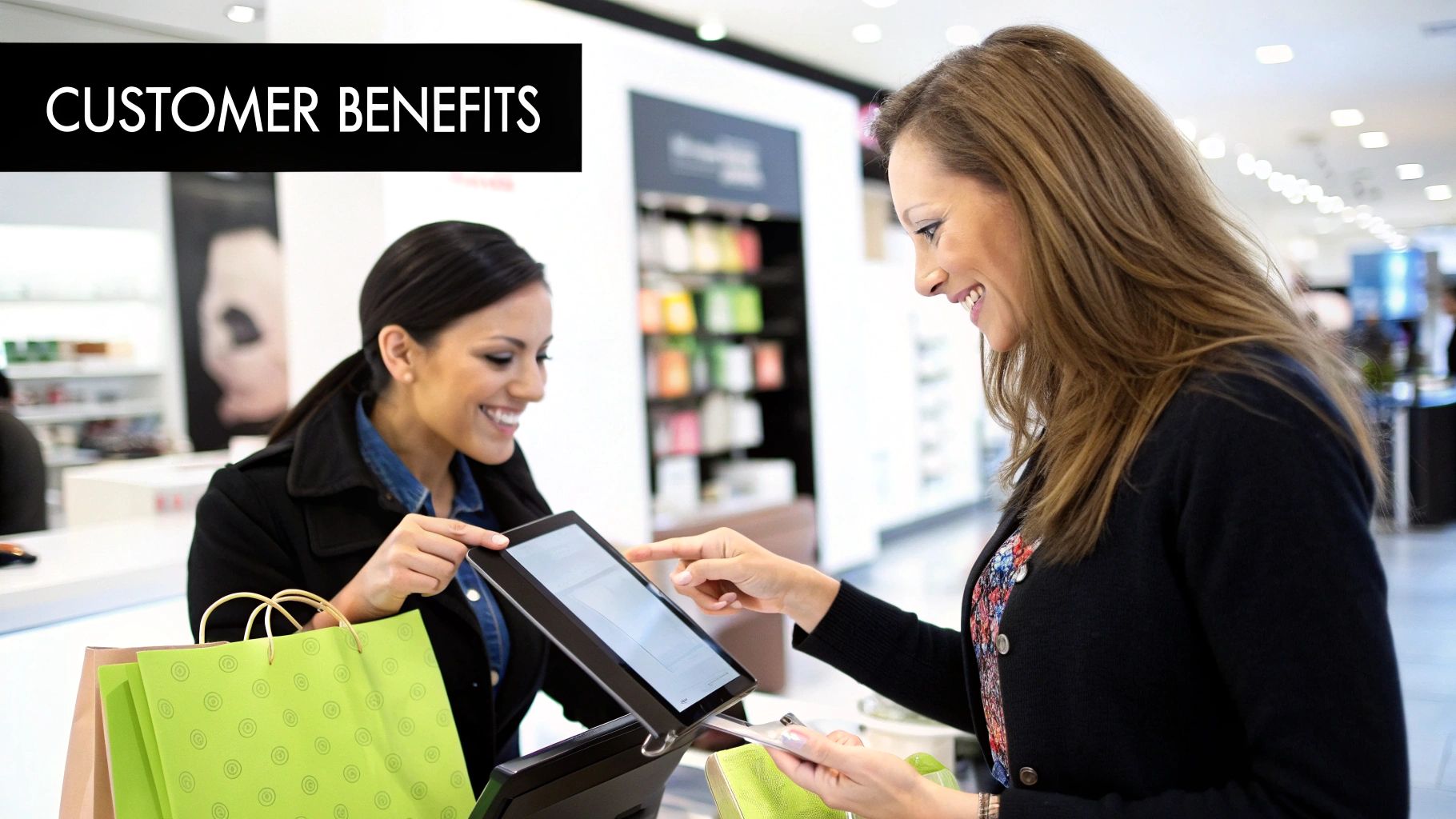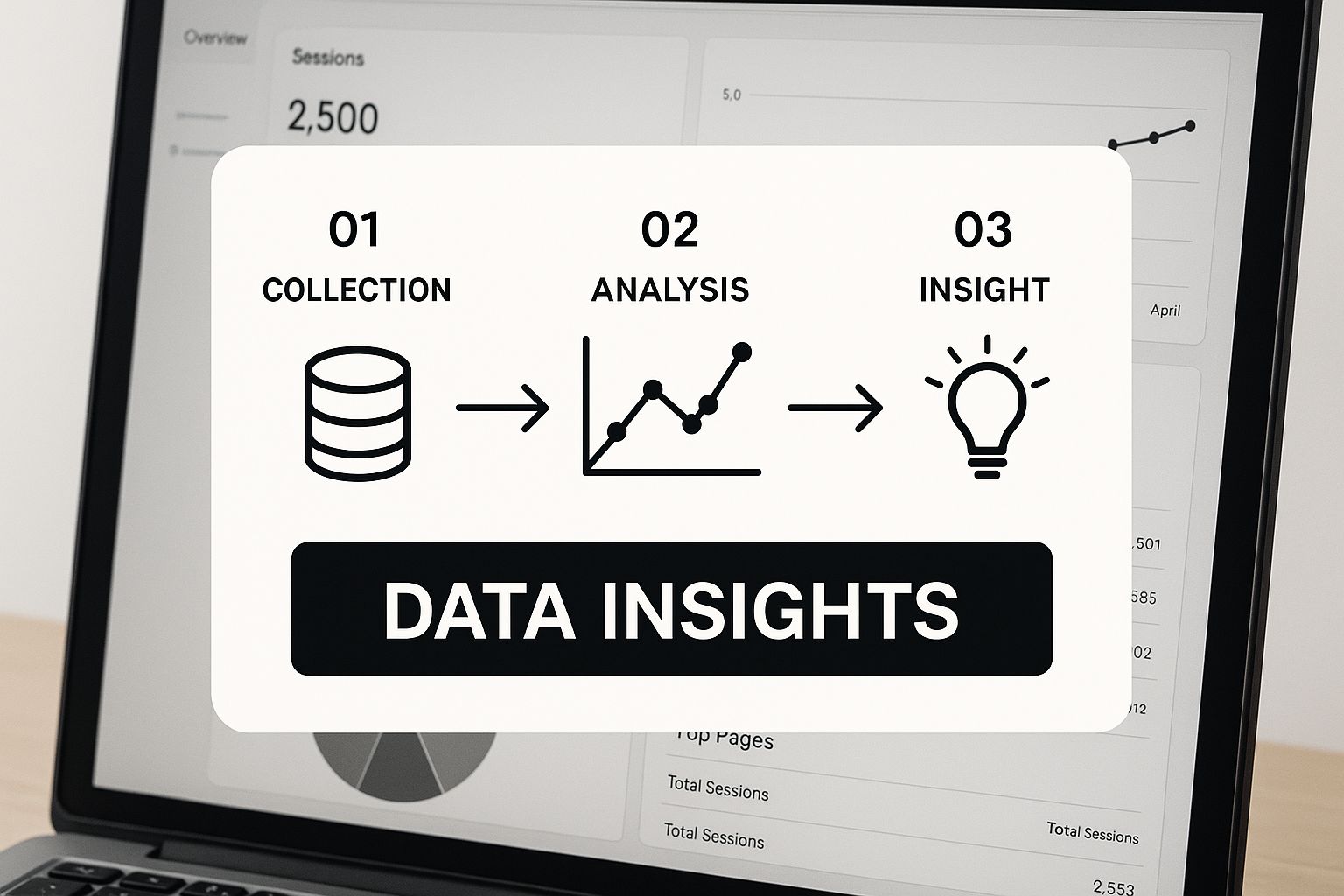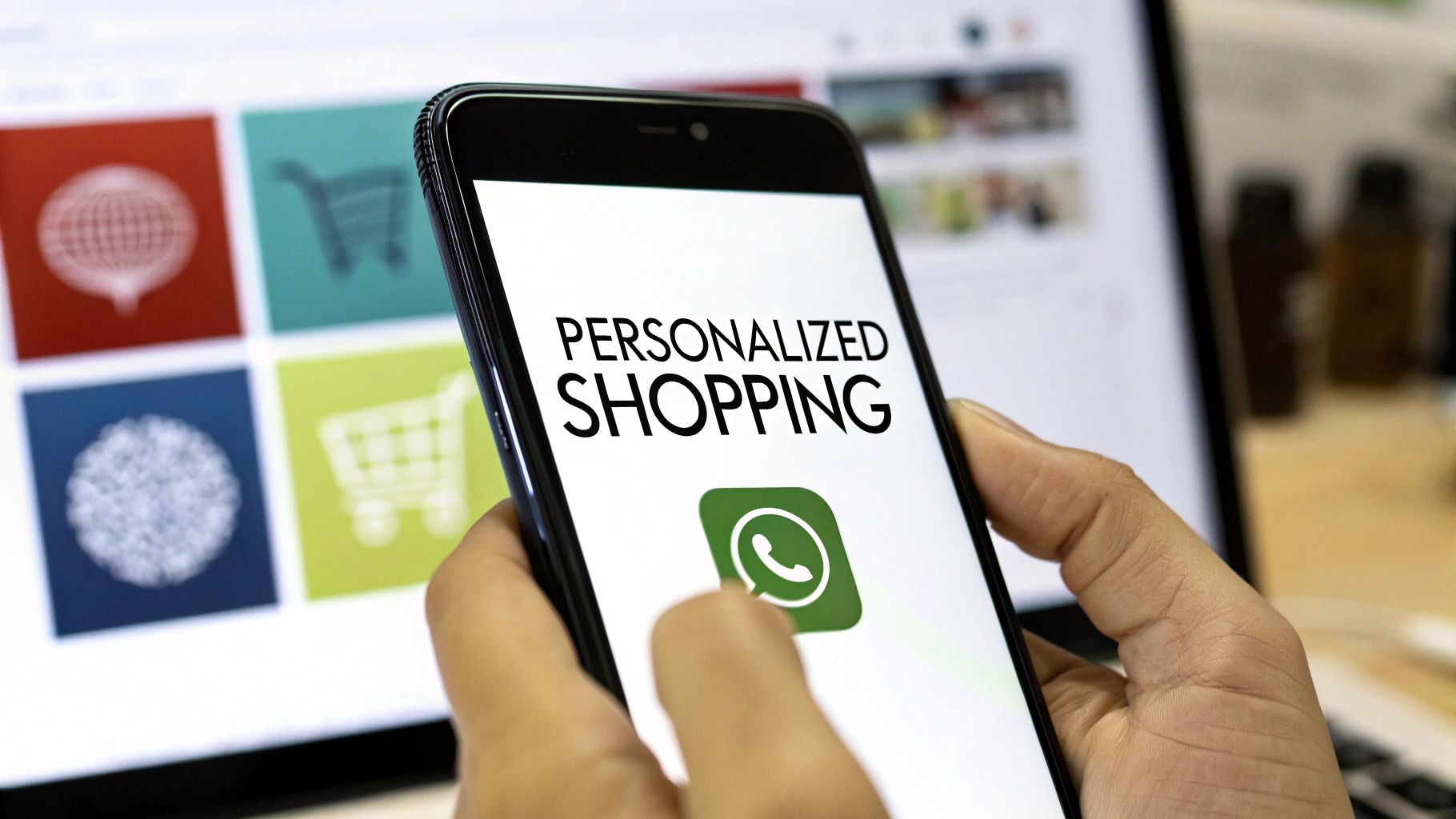Let's be real—the days of "one-size-fits-all" e-commerce are long gone. You're fighting for every click, and if your marketing feels generic, you're losing. A genuinely personalized shopping experience isn't just a nice-to-have; it's the most powerful tool you have to turn casual browsers into loyal customers. It means ditching the email blasts and starting real, one-on-one conversations that help people buy.
In this playbook, you'll learn exactly how to use WhatsApp to cut through the noise, build real customer relationships, and drive predictable revenue.
Why Your Generic Marketing Is Falling Flat
We've worked with over 500 Shopify stores, and we see the same painful story play out: customer fatigue from generic marketing leads straight to sky-high cart abandonment and dismal engagement. Your customers are bombarded with ads. Sending them the same message as everyone else is the fastest way to get ignored.
The data backs this up. A mind-boggling 75% of consumers will ditch their cart simply because they feel overwhelmed by choice. To really get ahead, you have to understand the modern playbook for mastering personalized shopping experiences that actually connect with people.
A recent report found that about one-third of shoppers are actively trying new brands, making customer loyalty harder than ever to secure. This highlights the urgent need to build stronger, more personal connections. You can explore the full findings on 2025 consumer trends on attentive.com.
So, how do you actually create interactions that lead to sales? You meet your customers where they already are.
Meet Your Customers Where They Already Are: WhatsApp
The answer is surprisingly simple: engage customers on the app they already use and trust for personal chats—WhatsApp. With a 98% open rate, it leaves email and SMS in the dust. This isn't about blasting another promotion. It’s about building a direct, personal relationship that guides a customer from discovery to checkout and beyond.
Let's look at how this practical approach stacks up against the old way of doing things.
Traditional Marketing vs. WhatsApp Personalization
The difference is stark. Moving these conversations to WhatsApp gives you a direct line to your customer, allowing you to be genuinely helpful. An abandoned cart becomes a supportive conversation. A post-purchase check-in turns into a natural cross-sell.
This is how you create a personalized shopping experience that doesn't just drive sales—it builds the kind of lasting customer relationships that fuel real, sustainable growth. To see this in action, check out our full guide on e-commerce funnel analysis that shows how to apply this at every stage.
How to Build Your Personalization Foundation on Shopify

A powerful personalized shopping experience doesn't happen by magic. It’s built on a solid foundation of the right tools and, more importantly, the right data. A common mistake we see is brands trying to personalize without having the proper infrastructure in place.
Choosing your e-commerce platform is the first domino to fall. While a Shopify vs WooCommerce vs BigCommerce platform guide can walk you through the options, we focus on Shopify because its rich data ecosystem is perfectly suited for creating these tailored customer journeys.
Your goal is to turn raw customer data—like purchase history and browsing behavior—into actionable insights. This is the fuel for every relevant message you'll send.
Connecting Your Data and Setting Up for Success
Your first practical step is integrating your Shopify store with a WhatsApp marketing platform like Kanal. This isn't just a technical task; it's how you unlock the deep customer data sitting dormant in your store. The integration is simple and takes just a few clicks to sync your product catalog and customer list.
A common mistake we see is brands not getting their WhatsApp Business Platform (WBP) account set up correctly. As an official Meta Business Partner, we can’t stress this enough: using the official WBP is crucial for scalability, compliance, and accessing advanced features. It ensures you’re building on solid ground.
Expert Tip: Don't just connect your store and hope for the best. After integration, verify that customer data like 'last order date' and 'viewed product' tags are syncing correctly. A five-minute check here can save you hours of troubleshooting later.
Moving Beyond Basic Customer Segmentation
Once your store is connected, you can move beyond simple tags like "new customer." True personalization requires creating micro-segments based on actual behavior.
Here are a few high-value segments we've seen our most successful clients build right away:
- High-Intent Browsers: Customers who have viewed a specific product more than twice but haven't purchased.
- Potential VIPs: Customers who have made two or more purchases in the last 60 days.
- Brand Loyalists: Shoppers who have purchased from a specific collection or brand multiple times.
Building these segments lets you craft hyper-relevant messages. You can send a targeted back-in-stock alert to your "High-Intent Browsers" or offer early access to a new collection to your "Brand Loyalists."
This approach is central to building lasting relationships, and it's even more powerful when you use one of the best loyalty apps for Shopify to complement your WhatsApp strategy. This is how you transform a generic broadcast into a welcome, one-on-one conversation that genuinely drives revenue.
How to Craft WhatsApp Automations That Actually Convert
Alright, you’ve laid the groundwork with solid customer data. Now for the fun part: turning those insights into an automated sales machine that works 24/7. This is where you create a truly personalized shopping experience on WhatsApp. We're talking about smart, timely conversations that feel less like marketing and more like a helpful store assistant.
From our experience with over 500 Shopify stores, the automations that generate the most revenue are the ones that solve a specific problem for a customer at the exact moment they need help.

The Anatomy of a Perfect Abandoned Cart Flow
Let's dive into the undisputed champion of e-commerce automations: abandoned cart recovery. A common mistake we see is sending a single, aggressive "Come back and buy!" message. The strategy that consistently delivers the best results for our clients is a multi-message flow that starts with help and ends with a sale.
The first message is crucial. Send it to their WhatsApp about 30-60 minutes after they leave your site. The tone? Pure customer service.
Here’s a template that just works:"Hey {{first_name}}! Looks like you left a few things in your cart. Just wanted to see if you had any questions or ran into any issues at checkout. I'm here to help! - Sarah from [Your Brand]"
See the difference? It's a conversation opener, not a demand. If that doesn't bring them back, a follow-up message about 6-8 hours later can introduce a gentle nudge, like free shipping or a 10% discount. This simple, two-step approach has helped our clients recover up to 18% of their abandoned carts.
How to Increase Lifetime Value with Post-Purchase Flows
Don't let your customer relationship end at the order confirmation. That’s where the real work of building loyalty begins. A smart post-purchase automation can significantly boost your Customer Lifetime Value (LTV)—the total amount a customer spends with you over time.
A fantastic starting point is a personalized cross-sell. Wait about 7-10 days after the order has been delivered, then send a message with a highly relevant product recommendation.
- Sold a coffee machine? Offer them your best-selling espresso beans.
- They bought shampoo? It's the perfect time to suggest the matching conditioner.
- Purchased a dress? Show them the earrings that other customers frequently bought with it.
The key is to make the suggestion feel like a natural next step. For a deeper dive into setting up these kinds of welcome sequences, our guide to customer onboarding automation has some great frameworks to get you started.
How to Take Conversational Commerce to the Next Level with AI
If you've mastered rule-based automation, you're ahead of the game. But the real magic—the future of e-commerce—is tapping into AI. This is where you graduate from segmented campaigns to a dynamic, one-on-one shopping experience that unfolds in real time. We're talking about moving beyond static flows and into conversations that think and adapt on the fly.
At Kanal, we've seen firsthand how our clients are using AI to rethink their sales and support on WhatsApp. It’s the difference between a chatbot that just follows a script and one that actually understands what your customer wants. For example, a customer asks, "Do you have this in blue?" A basic bot gets stuck. An AI-powered assistant, however, can instantly pull up the blue version, suggest a matching scarf, and help them check out right in the chat.
This isn't just a "nice to have" feature. According to personalization trends on Shopify's blog, tailored mobile experiences are an expectation, not a surprise.
Putting AI into Practice: What to Do First
So, what does this look like in the real world?
One of the most powerful strategies we've seen our clients implement is an AI-powered product finder. Instead of a customer getting lost on your site, they can just type what they're looking for in natural language:
- "I need a waterproof jacket for hiking that's under $200."
- "Show me your best-selling vegan leather tote bags."
- "I'm looking for a birthday gift for my mom; she likes gardening."
The AI acts like a personal shopper, instantly sifting through your Shopify catalog and presenting the most relevant products inside the WhatsApp conversation. It's fast, intuitive, and incredibly effective at reducing friction.
Our Expert Take: A common hurdle we see is brands worrying that AI will feel cold or robotic. The secret is training. We guide our clients to feed their AI with past customer service chats and brand voice guidelines. This teaches the AI to adopt your unique personality so it sounds helpful and on-brand.
Key Personalization Touchpoints in the Customer Journey
To truly make an impact, you need to know when to inject these personalized moments. It's about deploying technology at critical points to guide customers from discovery to purchase and beyond.
Here’s a breakdown of the most critical moments where you can use AI-powered personalization on WhatsApp to drive real results.
By strategically placing these interactions, you're not just selling a product; you're building a relationship that keeps customers coming back.
Measuring What Matters: How to Boost Your Customer Lifetime Value

Here’s a hard truth: you can't improve what you don't measure. A personalized shopping experience feels great, but if it isn’t boosting your bottom line, it’s just a vanity project. We always tell brands to laser-focus on three core metrics: your Conversion Rate, your Average Order Value (AOV), and the north star—Customer Lifetime Value (LTV).
LTV is the total profit you'll make from a single customer. Growing that number is the most reliable way to build a business that thrives.
Find Your Money-Making Automations
First, you need to know which of your WhatsApp automations are actually working. Inside the Kanal analytics dashboard, you can see the direct revenue impact of every single flow—no more guesswork.
From our experience with over 500 Shopify stores, a clear pattern has emerged. The most profitable flows are consistently:
- Abandoned Cart Recovery: This is your lowest-hanging fruit and your #1 revenue driver.
- Post-Purchase Cross-sells: Catching a customer with a relevant add-on right after a purchase is incredibly effective.
- Win-back Campaigns: Re-engaging customers who haven't bought in 90-120 days with a thoughtful offer restarts their LTV clock.
Once you see this data, you can double down on what's working. To help you get started, we built a free customer lifetime value calculator.
A Simple Framework for A/B Testing on WhatsApp
Knowing your best flows is just the starting point. The real growth comes from constant testing and optimization. A classic mistake we see is to "set it and forget it."
We've seen clients increase their LTV by over 30% within three months just by systematically A/B testing their WhatsApp messages. It's a predictable engine for growth.
The key is to be methodical. Test one variable at a time to get clean, actionable data.
Here’s a simple framework we recommend:
- Timing: Does a cart reminder sent at 30 minutes outperform one sent at 60 minutes?
- Offer: Pit a 10% discount against a free shipping offer.
- Copy: Test a direct call-to-action like "Complete Your Order" against a softer "Take Another Look."
- Tone: Test an urgent message against one that's more helpful and service-focused.
This disciplined approach turns your personalization strategy from a guessing game into a data-driven science.
Common Questions About WhatsApp Personalization
We get it—jumping into a new channel like WhatsApp can feel daunting. Based on helping hundreds of Shopify stores get started, we hear the same smart questions over and over. Here are honest, practical answers.
Is WhatsApp Personalization Only for Large Brands?
Absolutely not. This is probably the biggest myth we see. While big players are on WhatsApp, the tools are incredibly accessible for growing stores. In fact, smaller brands have an advantage because they can be more agile and build genuine one-on-one connections.
The trick is to start smart. A common mistake is trying to build a dozen complex automations at once. Don't do that. Focus on one or two high-impact flows. A solid abandoned cart recovery flow, for example, can start bringing in revenue from day one, proving the channel's value regardless of your size.
Will My Customers Find WhatsApp Messages Intrusive?
This is an important question. The answer boils down to three things: consent, relevance, and value.
First, customers must explicitly opt-in to hear from you on WhatsApp. They are giving you permission to enter their most personal inbox. As long as your messages are timely and genuinely useful—like a back-in-stock alert for an item they wanted—it feels like great customer service, not an intrusion.
From our experience, well-executed campaigns have unsubscribe rates below 1%. When you respect the customer's space and only send things they actually care about, they don't just tolerate it—they appreciate it.
How Much Technical Skill Is Needed to Get Started?
Honestly, very little. We built tools like Kanal specifically for e-commerce owners, not developers. You should spend your time on marketing and strategy, not fumbling with code.
With a direct Shopify integration, connecting your store is a matter of a few clicks. Building your first personalized shopping experience is done with a visual, drag-and-drop editor. We even have pre-built templates for the most common scenarios, so you can realistically launch your first campaign in less than an hour.
The entire retail world is shifting. Recent data shows that nearly 50% of shoppers worldwide used their phones for their last retail purchase. As you can read more about personalizing the shopping journey on visaacceptance.com, this mobile-first mindset means meeting customers on their favorite channels is no longer optional.
Creating a personalized shopping experience is the key to standing out and building a loyal customer base. By focusing on helpful, data-driven conversations on WhatsApp, you can turn a leaky funnel into a powerful engine for growth.
Ready to build your own high-converting flows? Install Kanal on your Shopify store today or get a personalized demo to see it in action.



